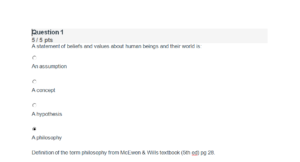Question 1
5 / 5 pts
A statement of beliefs and values about human beings and their world is:
An assumption
A concept
A hypothesis
A philosophy
Question 2
5 / 5 pts
A set of logically interrelated concepts, statements, propositions, and definitions supported by data, testing, and verification to account for or characterize some phenomena is called:
An assumption
A construct
A model
A theory
Question 3
5 / 5 pts
__________ is a theory that has been developed by another discipline (not nursing) but may be adapted to use in nursing and other fields
Borrowed theory
Grand theory
Middle range theory
No answer text provided.
Question 4
5 / 5 pts
The most abstract and general component of the structural hierarchy of nursing knowledge is called:
A construct
A metaparadigm
A model
No answer text provided.
Question 5
5 / 5 pts
A theory that has been developed by a nurse to account for a phenomenon or concern related to nursing is:
A conceptual model
A hypothesis
A nursing theory
A worldview
Question 6
5 / 5 pts
The nursing paradigm identifies four concepts of interest to the nursing profession. These four concepts are:
Concepts, definitions, relationships, and assumptions
The person, health, environment/situation, and nursing
The individual, groups, situations, and interests specific to nursing
Description, explanation, prediction, and prescription of an interrelationship of nursing
Question 7
5 / 5 pts
A group of theories that are broad in scope, complex, and provide broad and abstract views about nursing are called:
A grand theory
A metatheory
A middle range theory
No answer text provided.
Question 8
5 / 5 pts
A group of theories that are more limited in scope, less abstract, reflect practice, and addresses a specific phenomenon are called:
A grand theory
A metatheory
A middle range theory
No answer text provided.
Question 9
5 / 5 pts
A central construct in nursing would be:
Caring
Environment
Health
Person
Question 10
5 / 5 pts
What do the following theories written by Watson, Swanson, Duffy, Boykin & Schoenhofer, and Hall have in common?
They focus on adaptation
They focus on care and caring
They focus on comfort of the person/client
They focus on cultural care diversity and universality
Question 11
5 / 5 pts
An example of a nursing theory would be:
Benner’s Novice to Expert theory
Erikson’s developmental theory
Lewin’s change theory
Maslow’s Hierarchy of needs theory
Question 12
5 / 5 pts
True or False: Concepts are words or phrases that refer to or describe a phenomenon.
True
False
Question 13
5 / 5 pts
Nursing theory influences nursing practice by:
Specifying actions or interventions to be provided
Identifying which professional nurse should provide care
Allowing for variation in provision of care
Enabling professional nursing to practice in isolation of the healthcare team
Question 14
5 / 5 pts
Which type of nursing practice theory would a nurse be more likely to choose to manage specific situations or issues in the practice setting?
Mercer’s Maternal Role Attainment theory
Ruland & Morre’s Peaceful End of Life theory
Lorig’s Chronic Disease Self-Management theory
All of the above
None of the above
Question 15
5 / 5 pts
The nurse is caring for a client who is struggling with increased intracranial pressure. The nurse makes sure the client has water to drink, has voided recently, and the room is quiet and dark. Which theory is demonstrated here?
Orem’s self-care deficit theory
Henderson’s need theory
Kolcaba’s comfort theory
Fawcett’s environmental theory
Question 16
5 / 5 pts
Match the nursing theorist to their nursing theory.
Self-care defecit
Dorothea Orem
Focus on interpersonal relationships
Hildegarde Peplau
Focus on goal attainment
Imogine King
Focus on humanistic science of nursing
Martha Rogers
General Systems Theory
Betty Neuman
Partial Question 17
1.67 / 5 pts
A nursing student in a graduate research course is exploring the reasons for using theory in nursing practice? Which statement represents the best answer(s) to this questions? Select all that apply.
Improving client outcomes
Renewing and updating practice
Enhancing quality of health care
Advancing the image of nursing in society
Giving direction to nurses to determine the effectiveness of interventions
Question 18
5 / 5 pts
A nurse is working with a client who has gained weight and experienced increased blood pressure and blood cholesterol levels in response to caring for his wife who has Alzheimer disease. The effect of the spouse’s illness on the client is most related to which central concept of nursing?
nursing
person
health
environment
Environment typically refers to the external elements that affect the person; internal and external conditions that influence the organism; significant others with whom the person interacts; and an open system with boundaries that permit the exchange of matter, energy, and information with human beings. Person refers to a being composed of physical, intellectual, biochemical, and psychosocial needs; a human energy field; a holistic being in the world; an open system; an integrated whole; an adaptive system; and a being who is greater than the sum of his parts. Health is the ability to function independently; successful adaptation to life’s stressors; achievement of one’s full life potential; and unity of mind, body, and soul. Nursing is a science, an art, and a practice discipline and involves caring.
Question 19
Model of skill acquisition (Novice to Expert)
Synergy model for patient care
Theory of self-care and chronic illness
Postpartum depression theory
Theory of caregiver stress
Question 20
5 / 5 pts
Which assertion best describes the current state of evidence-based practice (EBP) in nursing?
EBP in nursing has been fully realized and implemented.
EBP in nursing has been rejected in favor of other approaches.
EBP in nursing is waning in emphasis and was never fully implemented.
EBP in nursing is growing in emphasis, but its implementation is lagging behind.
Solution:

Click link below to purchase full tutorial at $20